Introduction
Communications is one of the most dynamically changing industries. We are surrounded by continually evolving, state-of the-art technology (wifi, smart phones, satellite TV, GPS) Advanced methods of communication have filtered into many industries and revolutionized their processes and procedures.
Understanding the advantage of utilizing Ethernet communications is important in helping the HVACR industry keep pace. Today, much of the HVACR industry lags behind in communications. Even highly complex building automation systems are generally operating using some sort of serial bus communication, which is almost 30 year old technology. And, new electronic controls being released in our industry are generally equipped for “bus” topology, perpetuating this antiquated method of communication between devices.
Figure 1 – Example of Serial Bus Topology
Components are “daisy chained”
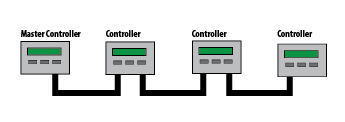
Advantages:
- easy to configure
- inexpensive
Disadvantages:
- limited to a few components compared to ethernet
- sends data one bit at a time
- if one component fails, all components downstream fail
- when problem occurs hard to determine where
- system expansion $$$
Serial Bus vs. Ethernet
Serial bus topology connects all devices to a host, but it is not a stand-alone solution for larger applications. Figure 1 shows a familiar example of a serial bus arrangement of devices.
Wired or wireless Ethernet communications (the way that most people connect to the Internet) provides a much faster experience, remote monitoring and management of devices. However, all Ethernet communications are not created equal. The physical arrangement, or topology, of a network, including the configuration of computers, and other peripherals is the first step in developing a network (a collection of resources, i.e. computers, printers, controllers, servers).
Ethernet Topologies – Bus – Star – Tree
There are three main Ethernet topologies, the Bus, the Star and the Tree.
Bus Topology
The original Ethernet communication standard released in 1983 was organized in a bus topology.
In a bus topology each node (controllers, monitors, printers) is physically linked in a simple chain, shown in Figure 2. It shares the serial bus problem of no fault tolerance. Similar to older style Christmas lights, if one of the lights in the chain goes out, the whole string goes out. And, just like those Christmas lights, it is difficult to identify the source of the problem if a break, cut, or failure occurs.
The bus topology is impractical when dealing with more than a few linked devices. Expanding beyond a few nodes requires costly gateways, eliminating the main advantage of a bus arrangement. In the HVACR industry, many manufacturers still encourage this style of communication through their product design, providing additional ports on the device that encourage “daisy chaining” components. Using bus topology creates a less reliable network.
Figure 2 – Linear Bus Topology / 10 Base 2
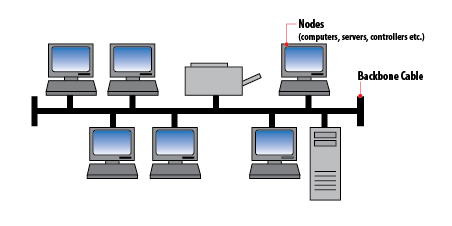
Advantages:
- can provide realtime data, remote
- monitoring and management of devices
- easy to configure
- relatively inexpensive
Disadvantages:
- limited to a few components
- if one component fails, whole string fails
- when problem occurs hard to determine where problem is in system
- to expand system costly gateways are needed
- not typically used anymore
- requires coaxial cable
Star Topology
After realizing the inherent flaws with bus topology, enhancements were made to increase the stability of the network. The result is the star configuration, shown in Figure 3. In the star topology the individual nodes are linked to a switch (sometimes inappropriately referred to as a hub). The switch speaks directly to each controller, or to other switches. In addition nodes can communicate with each other. Occasionally a switch will go down, however by linking several switches together, the various stars are linked. The devices can then communicate using the alternate switch. See Figure 4. With this structure it is also easy to detect faults, and make the appropriate repairs – especially critical when perishable inventory is at stake.
Figure 3- Star Topology
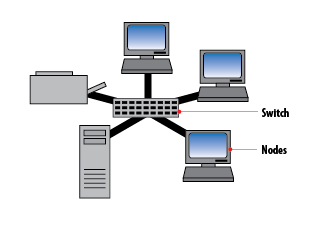
Advantages:
- natively provide data, remote monitoring and management of devices
- easy to configure
- communication from switch to each node
- increased stability – if node fails will not disable other nodes
- easy to detect faults and make repairs
- easy to detect faults and make repairs
Figure 4 – Star Topology Linked to Other Stars
Provides increased system stability — if one switch goes down, communications are automatically re-routed through another switch.
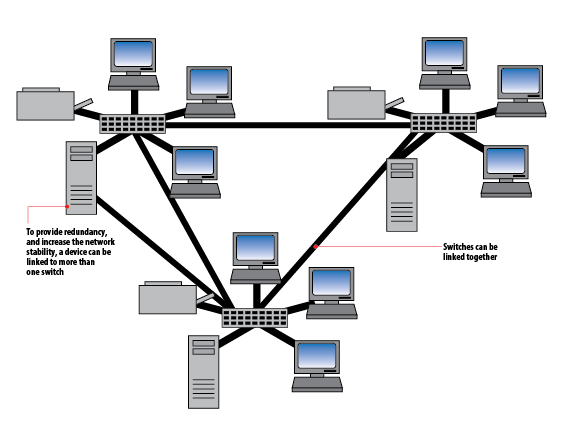
Advantages:
- provides realtime data, remote
- monitoring and management of devices
- communication from switch to each node
- increased stability
- switches can be hooked together
- nodes can connect to more than one switch; provides alternate communication path if a switch goes down
- easy to detect faults and make repairs
Disadvantages:
- more complicated to configure
- requires more cable than other topologies
- more expensive due to the cost of hubs
Tree Topology
A third topology has evolved as a hybrid of the bus and star topologies. It is known as a tree. An example of the tree is shown in Figure 5. Like the bus, the tree features a backbone cable, however instead of individual nodes connected to the cable, the tree topology has stars branching off. The disadvantage of the tree is similar to that of the bus. If the main line breaks, an entire segment fails. Additionally, the tree topology is more difficult to configure and wire.
Figure 5 – Tree Topology
Hybrid of linear bus and star topologies – less stable than the star, if the backbone breaks and entire segment goes down
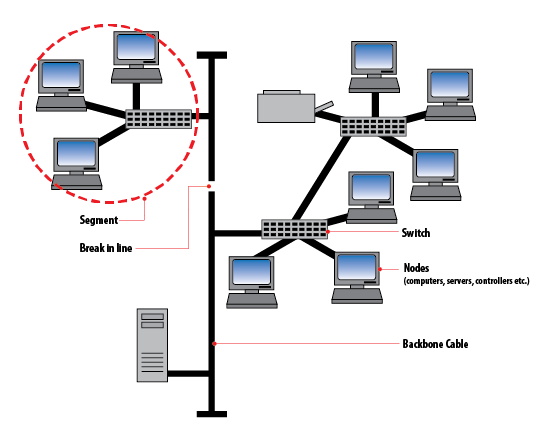
Advantages:
- provides realtime data, remote
- monitoring and management of devices
- communication from switch to each node
- increased stability
- switches can be hooked together
- nodes can connect to more than one switch; provides alternate communication path if a switch goes down
- easy to detect faults and make repairs
Disadvantages:
- If backbone breaks entire segment goes down
- more difficult to configure and wire
- length of each segment limited by the type of cable used.
Conclusion
From complex topologies to the most simple, Ethernet offers efficient ways to connect across many platforms such as Mac, PC, Linux, Unix and IBM mainframes. Ethernet is more popular than any other protocol and is widely used for all types of communications.
